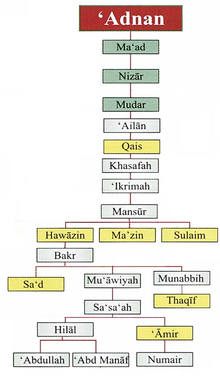
Back هوازن Arabic Həvazin Azerbaijani Hawazin Catalan هوازن Persian Hawazin French Bani Hawazin ID Banu Hawazin Italian Bani Hawazin MIN Hevazin Turkish بنو ہوازن Urdu
| Hawazin (Arabic: هوازن) | |
|---|---|
| Qaysi, Adnanite, Ishmaelite | |
 Banner of the Hawazin at the Battle of Siffin | |
| Nisba | Adnanite, Ishmael Firstborn son of Abraham |
| Location | Hejaz |
| Descended from | Hawazin ibn Mansur ibn Ikrima ibn Khasafa ibn Qays ʿAylān ibn Mudar ibn Nizar ibn Ma'add ibn Adnan. |
| Parent tribe | Qays |
| Branches | |
| Religion | Polytheism (Pre-Islam) Islam (Post Islam) |
The Hawazin (Arabic: هوازن / ALA-LC: Hawāzin) were an Arab tribe originally based in the western Najd and around Ta'if in the Hejaz. They formed part of the larger Qays tribal group. The Hawazin consisted of the subtribes of Banu Sa'd, and Banu Jusham, as well as the powerful Banu Thaqif and Banu Amir, which were both often counted separately from the Hawazin.
The tribe often clashed with their one-time patrons, the Ghatafan, and on occasion, sub-tribes of the Hawazin fought each other. The tribe had little contact with the Islamic prophet Muhammad until 630 when they were defeated by Muhammad's forces at the Battle of Hunayn. The Hawazin tribe were one of the first to rebel and fight against the early Muslim state based in Medina during the Ridda wars, which followed Muhammad's death in 632.
According to oral tradition and genealogy studies, the modern-day tribe of Otaibah based in Saudi Arabia are descendants of the Hawazin.[1][2][3]

- ^ Al-Qthami, Hmood Dawi (1985). North of Hejaz. Jeddah: Dar Al Bayan.
- ^ Al Rougi, Hindees. "The Tribe of Otaibah". Archived from the original on 2018-05-14. Retrieved 2017-11-19.
- ^ H. Kindermann-[C.E. Bosworth]. "'Utayba." Encyclopaedia of Islam. Edited by: P. Bearman, Th. Bianquis, C.E. Bosworth, E. van Donzel and W.P. Heinrichs. Brill, 2007.